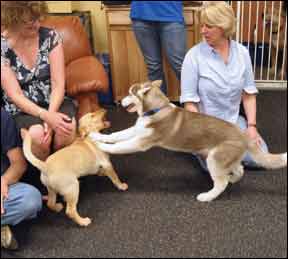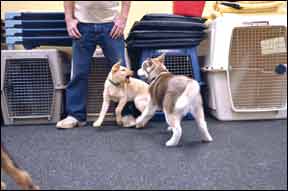So, what should you do if your dog is the victim of a canine bully? Intervene, by all means. Here are some of the signs to look for that tell you that you need to step in and break up the interaction. Your dog:

288
-Tries to get away or hides behind you, or behind chairs.
-Offers appeasement behaviors (ears back, squinty eyes, lowered body posture, rolls on her back, urinates) to signal the other dog to back off.
-Snaps at the other dog when his appeasement signals are ignored.
-Doesn’t offer to re-engage if there is a pause in the action.
-Just doesn’t look like he’s enjoying himself.

288
If you see any of these signs when your dog is interacting with another, step in and separate the dogs. Give both dogs a time-out to let arousal levels settle. If your dog was enjoying himself for a while but then became overwhelmed, you might try letting them play again. Watch closely. If the other dog starts to become inappropriate again, stop the play before your dog shows signs of discomfort. Give both dogs another time out, and try again.
Over time, the bully may learn that play stops every time he gets too rough, and start to self-inhibit his play. Alternatively, you can ask the bully dog’s owner to redirect her dog’s behavior to a different activity that will keep your dog safe, as we did with Lucy.
If your dog was intensely bullied from the start of the interaction, a serious fight erupted, you can’t redirect the bully dog’s behavior to another activity, or you’re not interested in risking your dog’s safety in the interest of modifying the other dog’s behavior, you’re better off ending the session after the first intervention.





